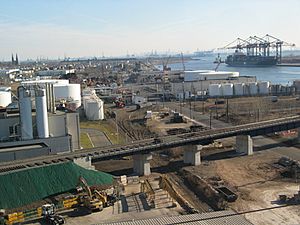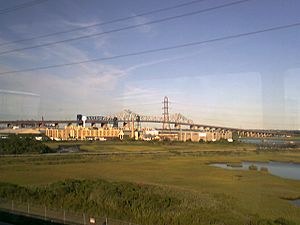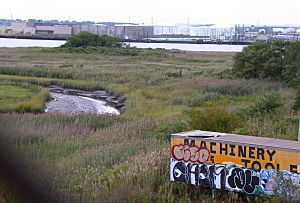Chemical Coast facts for kids
The Chemical Coast is a part of Union and Middlesex counties in New Jersey. It's located along the Arthur Kill, a waterway across from Staten Island, New York. This area gets its name from the Conrail Chemical Coast Line. This railway is a key part of the ExpressRail system, which helps move goods to and from marine terminals in the Port of New York and New Jersey.
Contents
History of the Chemical Coast
The name "Chemical Coast" was first used by Conrail. It described a freight railway line that served many chemical factories in the area. The railway line began in 1871 with the Perth Amboy and Elizabethport Railroad. However, this company ran out of money during the panic of 1873. It was then bought by the Central Railroad of New Jersey (CNJ).
Railroad Operations and Changes
The CNJ ran both freight (goods) and passenger trains on this line for many years. They called it the Perth Amboy and Elizabethport Branch. Passenger trains traveled to places like Bay Head Junction, Atlantic Highlands, Freehold, and Atlantic City. Famous trains like the Blue Comet used this line.
There were passenger stations at Newark Airport, Elizabethport, Carteret, and Sewaren. In Elizabethport, the CNJ also had a shop to repair train cars. Passenger service on this line stopped in 1967. This happened when trains were moved to Newark Penn Station as part of the Aldene Plan. In 1976, Conrail took over the line. They continued the important business of moving freight.
The CNJ built a two-track bridge over lower Newark Bay in 1864. In 1926, it was updated to two four-track lift bridges. These were known as the CRRNJ Newark Bay Bridge. This bridge connected to Bayonne and the Communipaw Terminal. From there, ferries went to New York City. After Conrail took over, the bridge between Bayonne and Elizabethport was taken down in the 1980s. Some stone parts of the bridge can still be seen.
Major Factories in the Area
In 1872, the Singer Manufacturing Company opened a factory in Elizabethport. It was next to the CNJ railway lines. In 1873, Singer became a New Jersey company. The factory survived a big fire in 1890. During World War II, the factory made items for the war effort. This included M1911 pistols. The factory closed in the late 1960s. By 2009, the old brick factory was used as an industrial park.
In 1907, John D. Rockefeller, who started Standard Oil, bought land between Linden and Elizabeth. This land became the Bayway Refinery. Construction started in 1908, and the refinery began working on January 2, 1909. The facility changed owners and grew bigger over the years. By 2002, ConocoPhillips owned it.
The Shell Oil Company opened a terminal in Sewaren in 1928. It was built on a 145-acre property. This terminal was later transferred to Motiva Enterprises, a Shell company. It grew to hold 4.2 million barrels of fuel. It connects to the Colonial pipeline and barge docks on the Arthur Kill. It also has rail connections. Today, this facility handles gasoline, diesel fuel, jet fuel, ethanol, and fuel mixtures.
Environmental Concerns and Railway Connections
Sometimes, odors from the chemical plants in this area can be smelled across the Arthur Kill. These odors affect the air quality in parts of Staten Island.
A freight train connection from New Jersey to the Staten Island Railway was reopened in late 2006. This connection uses the Chemical Coast line. The railroad bridge over the Arthur Kill waterway was also repaired. At least one freight train crossed from New Jersey to Staten Island in 2006. There are plans to use the North Shore of the Staten Island Railway again. This would allow more freight to move to and from the Howland Hook Marine Terminal.
Currently, the Chemical Coast connection to Staten Island is only for freight. However, there are also ideas to bring back passenger train service on Staten Island's North Shore Branch. Some plans suggest trains would go to Cranford Junction. Other ideas propose ending at the former Arlington or Port Ivory stations on Staten Island.
Modern Uses of the Chemical Coast
Ethanol and Biodiesel
In August 2006, the Linden Terminal intermodal facility opened. It is located on Point Tremley along the Arthur Kill in Linden. This facility moves ethanol (a type of fuel) between barges, train cars, trucks, and storage tanks.
In May 2007, a newspaper reported on Fuel Bio, a New Jersey company. This company makes biodiesel, a cleaner fuel. Their production facility is in Elizabeth, across the Arthur Kill from Staten Island.
Incidents on the Chemical Coast
The Chemical Coast has seen several incidents over the years.
- On October 25, 1972, an oil barge in Carteret exploded. This caused fires and oil spills in the Arthur Kill.
- A fire broke out at the GATX oil tank farm in Carteret on April 12, 1973.
- In 1995, a fuel vapor spray caused a fire at an Amoco fuel storage place in Carteret.
- On September 29, 2000, a tank car carrying 27,000 US gallons (102,206 liters) of butane went off its tracks. This happened in Woodbridge, New Jersey. People from 163 houses had to leave their homes while the area was cleaned up. The car was put back on the tracks later that day.
- An accidental gas explosion killed three workers on January 25, 2005. This happened at the Acetylene Service Company plant in Perth Amboy.
- On March 12, 2009, a tank car carrying isopropyl acetate leaked in Carteret. Conrail and the local fire department helped. The leak was fixed after about 100 US gallons (379 liters) had spilled.
- In 2012, during Hurricane Sandy, a storage facility owned by Motiva Enterprises spilled fuel. About 350,000 gallons (1,324,894 liters) of fuel went into the Arthur Kill.
- On July 5, 2016, at the Freeport McMoRan facility in Carteret, four chemical drums broke open. They released fumes, and several firefighters went to the hospital.




